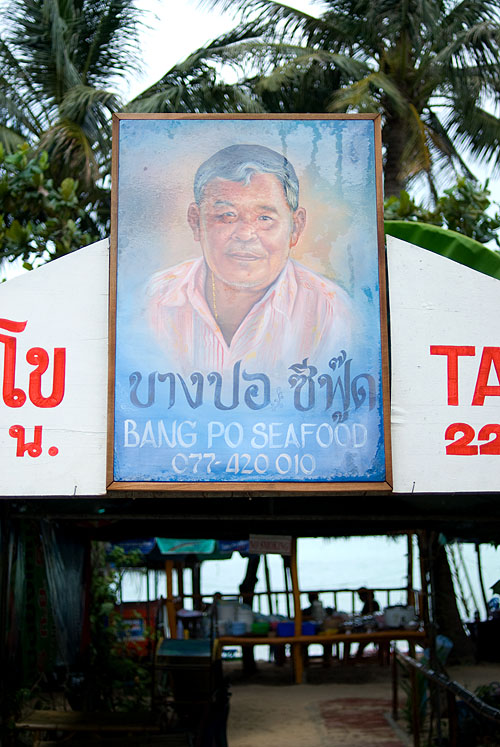 Throwing around superlatives can be a scary thing, but I think I'm justified in this case. I've been to many, many restaurants in Thailand, and have eaten some pretty amazing food, but Bangpo Seafood particularly stands out in my mind. I knew something was special about it after my first visit over a year ago, and wrote quite a few good things about it, but have always been keen to go back and see if the restaurant was really was as good as I thought.
Throwing around superlatives can be a scary thing, but I think I'm justified in this case. I've been to many, many restaurants in Thailand, and have eaten some pretty amazing food, but Bangpo Seafood particularly stands out in my mind. I knew something was special about it after my first visit over a year ago, and wrote quite a few good things about it, but have always been keen to go back and see if the restaurant was really was as good as I thought.
Well, after two recent visits, my initial impression was right, and I think Bangpo Seafood just might be my favourite restaurant in Thailand.
This informal beachside restaurant located on the northern coast of Ko Samui serves the local dishes of the island. This means lots of seafood, including some unusual ingredients such as waay, a type of small octopus, sea urchin roe and flying fish. Coconuts, a major crop on Ko Samui, feature in several dishes, including khaao man, rice cooked in coconut milk with a pinch of salt and dried green beans. This is the house carb, and apparently was how people on Ko Samui used to prepare their rice. And as with southern Thai food in general, veggies also play a large role, especially in khoei jii:
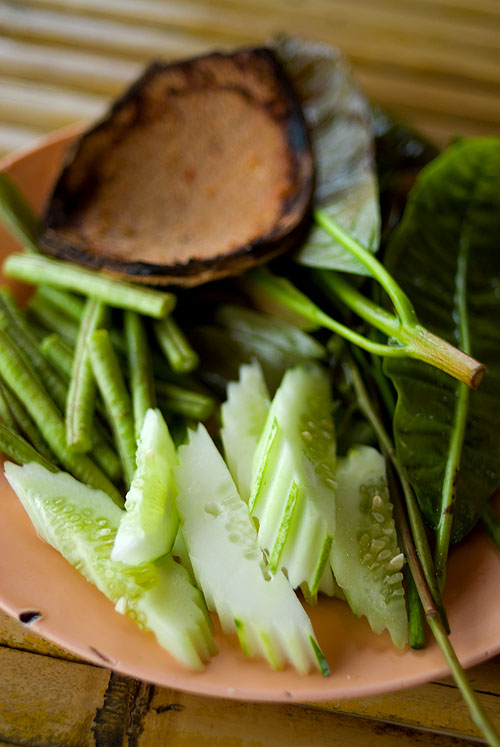
Shrimp paste pounded up with coconut meat, shallots, chilies and crab, smeared on the inside of a coconut shell then grilled over coals and served with local herbs such as young cashew tree leaves. This dish is given to everybody who walks in the door, and is far from being a throwaway appetizer. I'd be more than happy with a few of these and the previously mentioned coconut rice.
The first dish I ordered was plaa hoop ping:

Flying fish (plaa nok en) that is splayed, coated with a coconut milk/plack pepper/turmeric mixture, then grilled. The result is smokey, salty, oily--everything you'd want in a fish dish.
Yam saaraay:

A Thai-style 'salad' of a local variety of seaweed, which included sour mango and cockles, and oddly, peanuts.
The owner didn't exactly have to twist my arm to convince me to try two of Surat Thani's famous oysters:
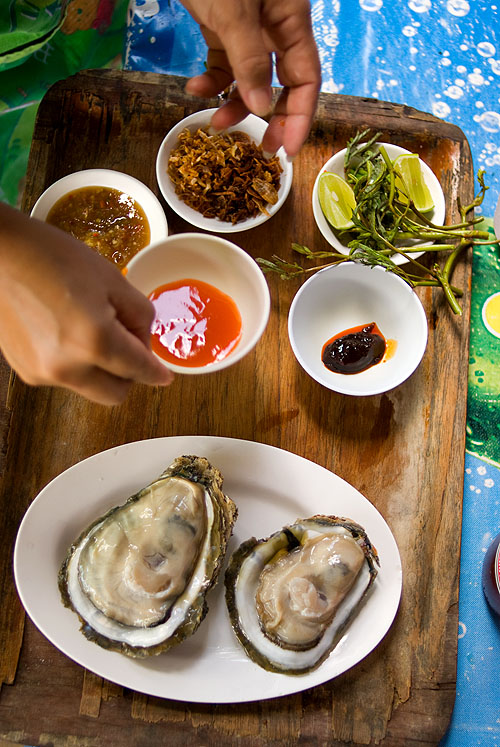
Served Thai style with accompaniments of naam phrik phao (a sweet/spicy chili sauce), lime, deep-fried crispy garlic and shallots, seafood dipping sauce and pungent krathin leaves. Despite how impressive they look, I found this the least interesting dish I ate at Bangpo Seafood. The oysters were simply too big, too tough, and had little flavour.
There was also plaa insee phat chaa:
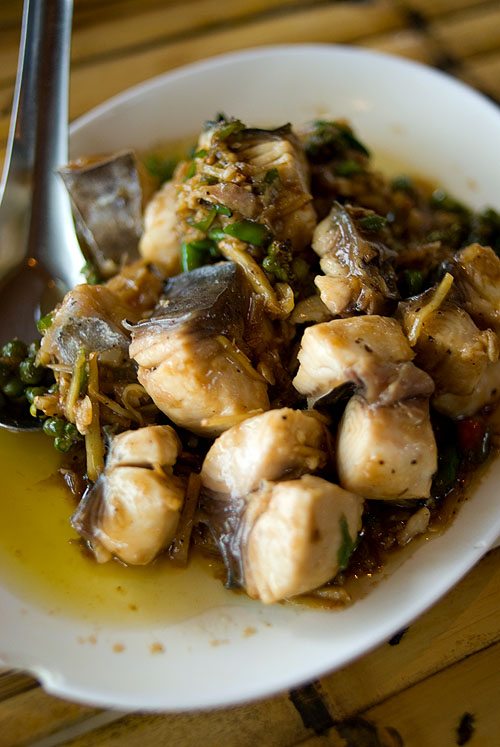
Mackerel stir-fried with fresh herbs. Very oily, as you can see, but the mixture of green peppercorns, krachai (Chinese key--a ginger-like root), garlic, Kaffir lime leaves and fresh fish was outstanding.
And these are just the dishes I ordered. While I was wondering how I could possibly consume all this, the owner's wife brought out a couple more dishes for me to try, including tom som waay:

a soup of a kind of small octopus made sour by the addition of tender young tamarind leaves, as well as several tiny deep-fried fish that one eats in one go, head and all.
And you know what? Other than the oysters, it was all outstanding.
So if this isn't enough to convince you to hop on the next plane, I don't know what else I need to do. However, a brief word of warning: apparently in the same area there are a couple identically named restaurants serving inferior food. If you aim to go to this one, be sure to make certain that you're at Ta Khoe's (the owner, pictured at the top of the post) restaurant.
The entire photoset can be seen here.
Bangpo Seafood (Ta Khoe)
6/4 Moo 6, Mae Nam
Ko Samui
077 420 010
lunch & dinner
 What do you eat when you're on a Thai island with 11 former students? Food from the country's landlocked rural northeast, of course. Last weekend on Ko Samet this meant sticky rice, grilled chicken and many, many dishes of som tam (a salad of unripe papaya):
What do you eat when you're on a Thai island with 11 former students? Food from the country's landlocked rural northeast, of course. Last weekend on Ko Samet this meant sticky rice, grilled chicken and many, many dishes of som tam (a salad of unripe papaya):
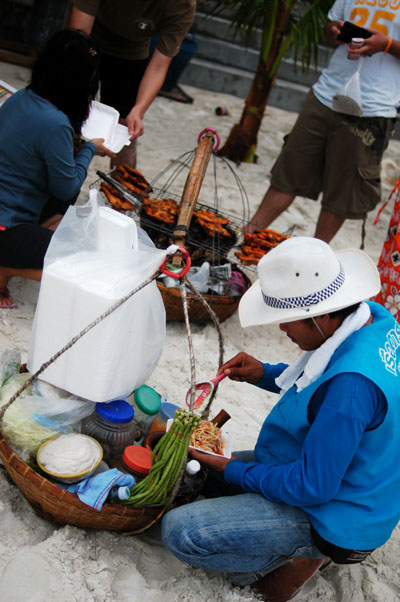

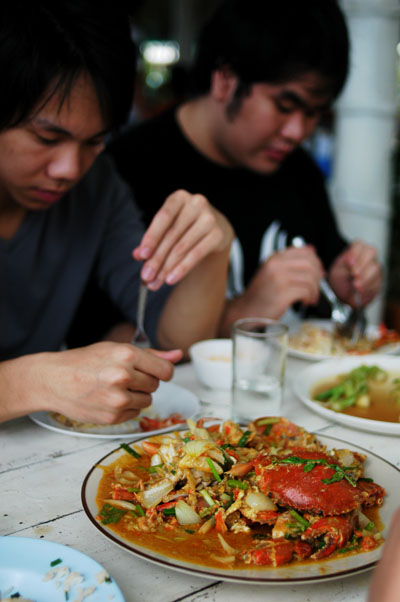














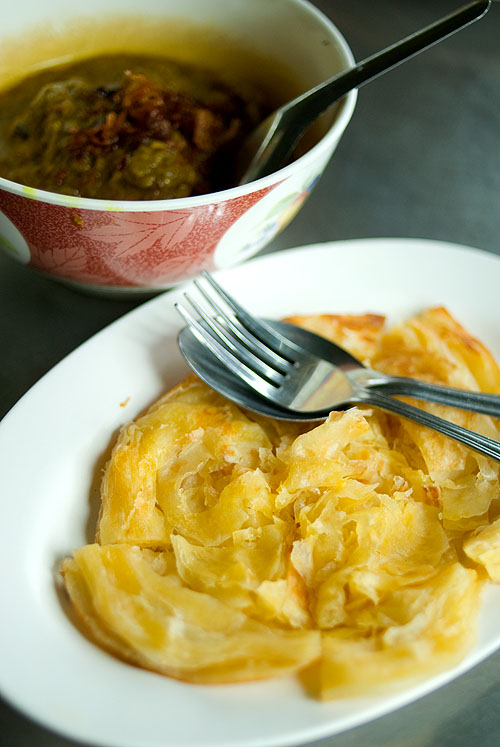 I've mentioned Yusup, a Muslim restaurant on the northern outskirts of Bangkok,
I've mentioned Yusup, a Muslim restaurant on the northern outskirts of Bangkok, 
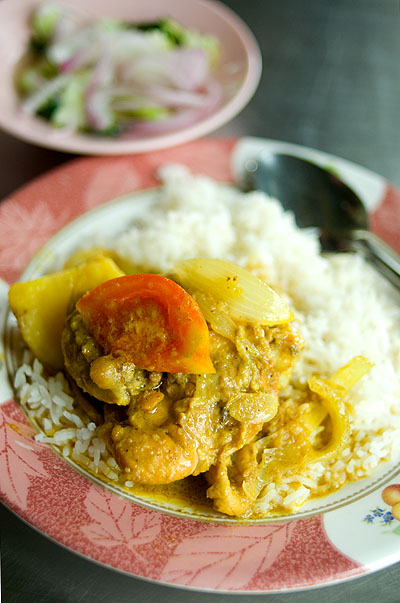


 After all this time, it looks like Thailand is set to get to be what appears to be a premium, domestically-made, and if the Gods are kind, drinkable beer: Federbräu. Brewed somewhat surreptitiously by ThaiBev (the brewers of Beer Chang) in Ayuthaya, the beer is a Blond Lager and contains 4.7% alcohol. Interestingly, many of the sites and blogs, not to mention the beer label itself, seem to make a point of mentioning that Federbräu is brewed following the famous Reinheitsgebot, ensuring its purity. But on a tour of a Singha Brewery a few years ago, the German-educated brewmaster ensured me that despite how it sometimes tastes, Singha also contains only water, barley, hops and yeast. Well, Singha had its chance, and iff they can get it right with Federbräu, I'll be switching loyalties very soon.
After all this time, it looks like Thailand is set to get to be what appears to be a premium, domestically-made, and if the Gods are kind, drinkable beer: Federbräu. Brewed somewhat surreptitiously by ThaiBev (the brewers of Beer Chang) in Ayuthaya, the beer is a Blond Lager and contains 4.7% alcohol. Interestingly, many of the sites and blogs, not to mention the beer label itself, seem to make a point of mentioning that Federbräu is brewed following the famous Reinheitsgebot, ensuring its purity. But on a tour of a Singha Brewery a few years ago, the German-educated brewmaster ensured me that despite how it sometimes tastes, Singha also contains only water, barley, hops and yeast. Well, Singha had its chance, and iff they can get it right with Federbräu, I'll be switching loyalties very soon.





















 In 2006 Krua Apsorn was chosen as one of the Bangkok Post's Best Restaurants (see clip
In 2006 Krua Apsorn was chosen as one of the Bangkok Post's Best Restaurants (see clip 



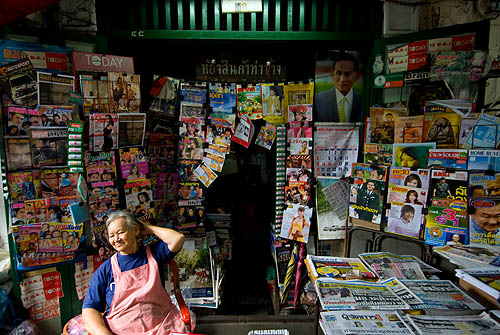 A newsstand at Tha Chang, Bangkok
A newsstand at Tha Chang, Bangkok
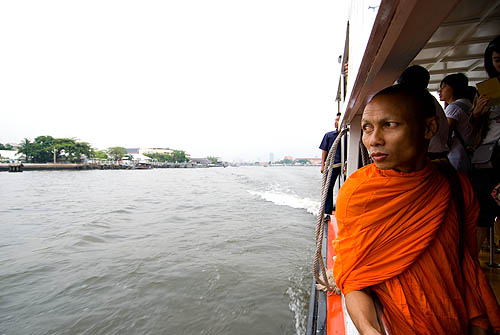

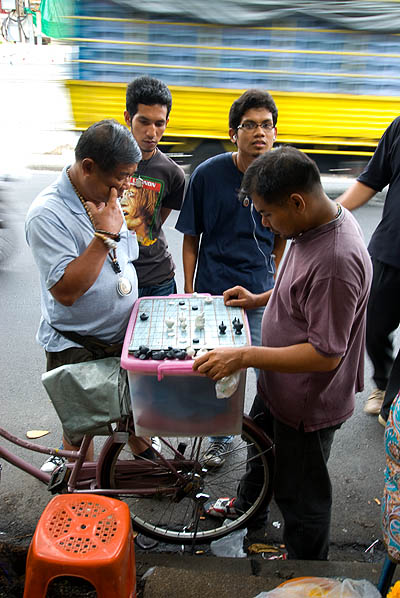
 \
\
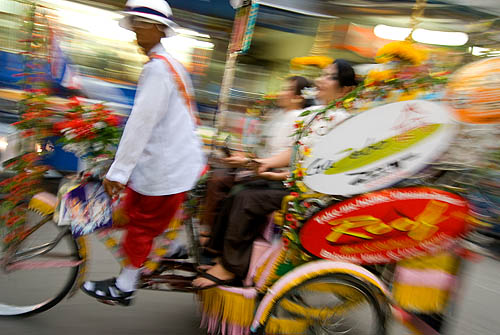
 The Nikon D300. Currently in waiting outside Chicago, USA. In my hands early May. For details, go in-depth reviews at
The Nikon D300. Currently in waiting outside Chicago, USA. In my hands early May. For details, go in-depth reviews at  Temple doors, Wat Ratchabophit.
Temple doors, Wat Ratchabophit.
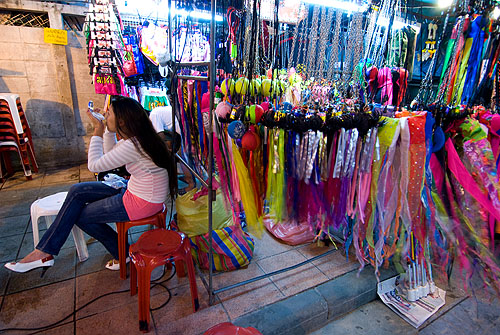

 Arguably Bangkok's most popular hawker stall, Naay Uan's recipe for success must lie in its simplicity. His kuay jap, a basic but delicious soup of of pork offal, thick rice noodles and broth draws literally hundreds of hungry diners to Chinatown every night:
Arguably Bangkok's most popular hawker stall, Naay Uan's recipe for success must lie in its simplicity. His kuay jap, a basic but delicious soup of of pork offal, thick rice noodles and broth draws literally hundreds of hungry diners to Chinatown every night:
 Bangkok, Thailand. ISO 2200.
Bangkok, Thailand. ISO 2200. Have you ever rented a car and driven to another province for a bowl of noodles? That's exactly what me,
Have you ever rented a car and driven to another province for a bowl of noodles? That's exactly what me, 
 For a larger version of this image go
For a larger version of this image go 








 It didn't take me long to discover that, unless you're a fan of mediocre Swedish food or bland Thai/Asian, you'll find little of interest to eat on the island of Phuket. The exception to this was Phuket Town, by far the most interesting and atmospheric place on the island, and virtually forgotten by the hordes of tourists who cling to the beaches. I was surprised to find that many of the traditional dishes you'll find there are nearly identical to
It didn't take me long to discover that, unless you're a fan of mediocre Swedish food or bland Thai/Asian, you'll find little of interest to eat on the island of Phuket. The exception to this was Phuket Town, by far the most interesting and atmospheric place on the island, and virtually forgotten by the hordes of tourists who cling to the beaches. I was surprised to find that many of the traditional dishes you'll find there are nearly identical to 







 I’m currently in Tokyo, so this is what my curries will be looking like for the next few days. I love this city and am here taking photos at Tsukiji, the world-famous seafood market, for a magazine article. Will post some pics from that, as well as some of the fun food I had in Phuket just before coming here, soon.
I’m currently in Tokyo, so this is what my curries will be looking like for the next few days. I love this city and am here taking photos at Tsukiji, the world-famous seafood market, for a magazine article. Will post some pics from that, as well as some of the fun food I had in Phuket just before coming here, soon. At a smoking area, Shibuya, Tokyo, Japan.
At a smoking area, Shibuya, Tokyo, Japan.



 Throwing around superlatives can be a scary thing, but I think I'm justified in this case. I've been to many, many restaurants in Thailand, and have eaten some pretty amazing food, but Bangpo Seafood particularly stands out in my mind. I knew something was special about it after my first visit over a year ago, and wrote
Throwing around superlatives can be a scary thing, but I think I'm justified in this case. I've been to many, many restaurants in Thailand, and have eaten some pretty amazing food, but Bangpo Seafood particularly stands out in my mind. I knew something was special about it after my first visit over a year ago, and wrote 





 Dancing ladyboys along Thanon Bangla, Patong, Phuket, of course:
Dancing ladyboys along Thanon Bangla, Patong, Phuket, of course:
 Reproducing famous works of art at Chaweng Beach, Ko Samui.
Reproducing famous works of art at Chaweng Beach, Ko Samui. Lunch at an unidentified curry restaurant, Ko Samui. Isn't food beautiful?
Lunch at an unidentified curry restaurant, Ko Samui. Isn't food beautiful? This pic makes me smile. She was originally from Bangkok, is a housekeeper at one of the big hotels at night, and by day is a vendor on Chaweng. Buy something from her if you see her!
This pic makes me smile. She was originally from Bangkok, is a housekeeper at one of the big hotels at night, and by day is a vendor on Chaweng. Buy something from her if you see her!